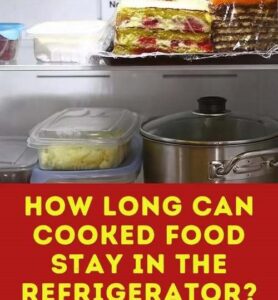How Long Can Cooked Food Stay in the Fridge Before It’s Unsafe to Eat?

When it comes to leftovers, safety matters just as much as taste. While many of us have taken a “sniff test” approach to see if food is still good, that’s far from reliable. Knowing exactly how long cooked food can safely stay in your refrigerator is essential—not only to preserve flavor, but also to prevent serious illness from foodborne bacteria.
🕒 So… How Long Is Too Long?
According to the U.S. Department of Agriculture (USDA), the golden rule is simple: 3 to 4 days. Most cooked dishes—including meats, casseroles, and soups—should be eaten or frozen within that time frame.
Even if food looks and smells perfectly fine after 4 days, it may still contain harmful bacteria like Listeria or Salmonella—both of which can multiply even at refrigerator temperatures.
❗ Why 3–4 Days Is the Sweet Spot
Refrigeration slows bacterial growth—but doesn’t stop it completely. The moment your meal begins to cool after cooking, microorganisms begin to multiply again. After about four days, the risk of food poisoning increases significantly—especially if the food wasn’t cooled properly or has been reheated multiple times.
🧾 Shelf Life of Common Cooked Foods
Here’s a quick guide for how long different types of cooked foods typically stay safe in the fridge:
| Food Type | Safe for… |
|---|---|
| Cooked chicken, beef, pork | 3–4 days |
| Casseroles and stews | 3–4 days |
| Cooked seafood | 2–3 days |
| Cooked rice and pasta | 3 days (up to 5 if stored perfectly) |
| Soups and broths | 3–4 days |
| Cooked vegetables | 3–4 days |
| Egg-based dishes (quiche, frittatas) | 3–4 days |
Important: These timelines only apply if the food is refrigerated within 2 hours of cooking. Leaving food out on the counter too long allows bacteria to take hold—and refrigeration won’t undo that.
👃 How Can You Tell If It’s Gone Bad?
Even if you’re within the 3–4 day window, always check for these warning signs:
-
A sour, off, or unusual odor
-
Slimy texture or discolored patches
-
Visible mold or fuzz
-
Bubbles or foam in soups and sauces
When in doubt? Toss it out. No meal is worth risking your health.
🧊 Smart Storage Tips for Safe Leftovers
To keep your cooked food safe for as long as possible, follow these storage best practices:
-
Cool quickly: Don’t let hot food sit at room temperature. Transfer it into shallow containers and refrigerate within 2 hours of cooking.
-
Seal it tight: Use airtight containers to prevent contamination and keep food fresher longer.
-
Label with the date: Use sticky notes, tape, or a marker so you always know when something went into the fridge.
-
Reheat thoroughly: Make sure leftovers reach at least 165°F (74°C) when reheated—this helps kill any lingering bacteria.
❄️ What If You Can’t Eat It In Time? Freeze It!
Not planning to eat your leftovers in the next few days? No problem—freeze them. Freezing halts bacterial growth completely. Most cooked meals stay safe in the freezer for 2 to 6 months, depending on the ingredients.
While freezing may alter the texture of certain dishes (like pasta or creamy sauces), it doesn’t make food unsafe. Just thaw properly and reheat all the way through when you’re ready.

✅ The Bottom Line
Most cooked food stays safe in the refrigerator for up to 4 days—but after that, the risk of foodborne illness rises. With proper storage, good labeling, and smart reheating, your leftovers can stay both safe and delicious. Just don’t push your luck by stretching meals longer than they should be.
Got questions about food safety, freezing, or reheating? Drop them in the comments—we’re here to help!